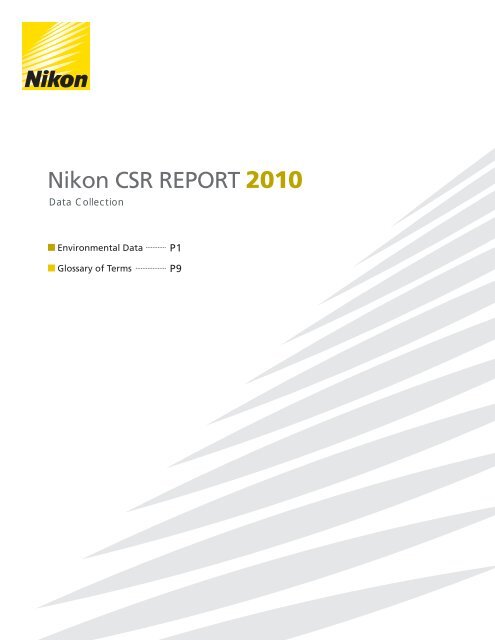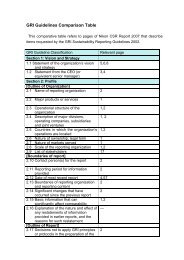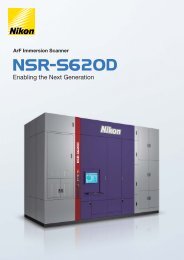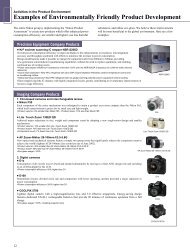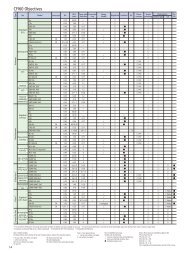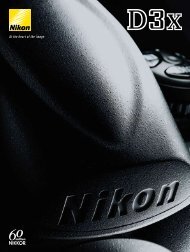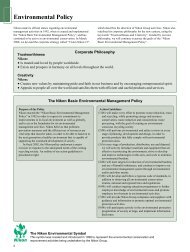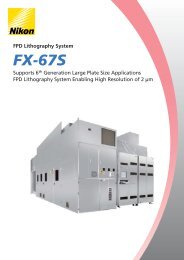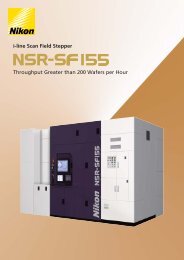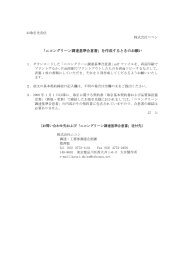CSR Report 2010 Data Collection Entire Pages (PDF: 386KB) - Nikon
CSR Report 2010 Data Collection Entire Pages (PDF: 386KB) - Nikon
CSR Report 2010 Data Collection Entire Pages (PDF: 386KB) - Nikon
Create successful ePaper yourself
Turn your PDF publications into a flip-book with our unique Google optimized e-Paper software.
<strong>Nikon</strong> <strong>CSR</strong> REPORT <strong>2010</strong>Environmental <strong>Data</strong>Glossary of TermsP1P9
2006–<strong>2010</strong> Energy use [<strong>Nikon</strong> Group Companies in Japan] 2006–<strong>2010</strong> CO2 emissions [<strong>Nikon</strong> Group Companies in Japan](t-CO2)4,0003,0001.001,3090.901,3060.801,3990.881,2980.901,182(Index)1.000.75(t-CO 2 )160,000120,0001.0061,0300.8455,9260.8666,9970.8861,6940.9555,763(Index)1.000.752,0001,886 1,9562,069 2,0071,8550.5080,00075,062 73,38690,641 87,86681,2600.501,0000.2540,0000.250’06/3 ’07/3 ’08/3 ’09/3 ’10/300’06/3 ’07/3 ’08/3 ’09/3 ’10/30<strong>Nikon</strong> CorporationMajor Group manufacturing companies in JapanEnergy use per net sales(Year/month)<strong>Nikon</strong> CorporationMajor Group manufacturing companies in JapanCO 2 emissions per net sales(Year/month)* The baseline year for calculating the energy use index per net sales is set asthe year ended March 2006. (Year ended March 31, 2006 = 1)* CO2 emissions indexes for the years ended March 2009 and March <strong>2010</strong>were calculated using the emission factor for the year ended March 2009.* The baseline year for calculating the CO2 emissions index per net sales is setas the year ended March 2006. (Year ended March 31, 2006 = 1)PRTR survey results (year ended March 31, <strong>2010</strong>)Major Group manufacturingcompanies in JapanFacilitySendai <strong>Nikon</strong> *1Hikari Glass Akita PlantTNI Industry Ohtawara FactoryTotalSubstanceno.Substance name69 Hexavalent-chromium compounds227 Toluene243 Barium and its water-soluble compounds304 Boron and its compounds144 DichloropentafluoropropaneVolumehandled2,6592,5733,94230,9681,23341,375Air02,0003438262,872Amount released Amount transferred Amountin on-siteSoil Sewage Waste landfillPublicwater0002020000000000001435741,54512,160014,422000000Amountremovedforprocessing000000Unit: kgAmountshipped inproduct*1 Including former Sendai <strong>Nikon</strong> Precision* <strong>Nikon</strong> Corporation: No PRTR substances at Ohi, Yokohama,Sagamihara, Kumagaya and Mito Plants.* Major Group manufacturing companies in Japan: No PRTR substances at Tochigi <strong>Nikon</strong>, Tochigi <strong>Nikon</strong> Precision, former Mito <strong>Nikon</strong> Precision, Miyagi <strong>Nikon</strong>Precision, and Kurobane <strong>Nikon</strong>.* The above table includes data only for hazardous chemical substances of which one ton or more (0.5 tons or more for Class 1 designated chemical substances) ishandled at the facility in a given year.* The volumes handled are not always identical to the sum of the constituents because of rounding.2,51602,39418,76340724,080Achievement of Zero Emissions Level 1 of <strong>Nikon</strong> Group<strong>Nikon</strong> CorporationGroupmanufacturingcompanies in JapanGroupmanufacturingcompanies in JapanCompanyAll plantsSendai <strong>Nikon</strong> *1Tochigi <strong>Nikon</strong> *2Kurobane <strong>Nikon</strong>Former Mito <strong>Nikon</strong> PrecisionMiyagi <strong>Nikon</strong> Precision(former Zao <strong>Nikon</strong>)TNI Industry Nagai FactoryNasu <strong>Nikon</strong>Aichi <strong>Nikon</strong>*1 Including former Sendai <strong>Nikon</strong> Precision*2 Including Tochigi <strong>Nikon</strong> PrecisionSystem complete(year-end)March 31, 2003(completed)March 31, 2002(completed)March 31, 2004(completed)March 31, 2004(completed)March 31, 2005(completed)March 31, 2005(completed)March 31, <strong>2010</strong>(completed)March 31, 2006(completed)March 31, 2007(completed)<strong>Nikon</strong> <strong>CSR</strong> REPORT <strong>2010</strong> <strong>Data</strong> <strong>Collection</strong>2
Environmental <strong>Data</strong>Waste by category (in the year ended March 31, <strong>2010</strong>)[<strong>Nikon</strong>’s Plants]11.7%6.4%30.8%4.4% 9.7%Total3,251tons2.3%3.6%0%0.6%19.8%2.0%8.7%PaperGeneral refuseWoodFiberGarbageSludgeOilAcidsAlkalisPlasticsMetalsGlass/ceramics(debris)Air & Water Quality Environmental <strong>Data</strong> for Each Plant(Year ended March 31, <strong>2010</strong>)* Where there is more than one figure indicated per item in the tables below,the plant has more than one facility.<strong>Nikon</strong> CorporationOhi PlantAddress: 6-3, Nishi-Ohi 1-chome,Shinagawa-ku, Tokyo140-8601, JapanPhone: +81-3-3773-1307Waste by category (in the year ended March 31, <strong>2010</strong>)[Group manufacturing companies in Japan]11.1%18.0%3.6%2.2%PaperGeneral refuse0%18.9%Total0% Wood2,512tonsFiber27.4%Garbage11.1%4.4%Sludge2.2%1.1%Discharge, disposal, and recycling of waste[<strong>Nikon</strong>’s Plants](tons)4,0003,5003,0002,5002,0001,5001,000500099.23,251 3,22410019 8’06/3 ’07/3 ’08/3 ’09/3 ’10/3 (Year/month) 0Amount of waste generated Amount recycled Amount of mass reductionAmount of landfill disposal Recycling rateDischarge, disposal, and recycling of waste[Group manufacturing companies in Japan](tons)3,0002,5002,0001,5002,51268.91,732OilAcidsAlkalisPlasticsMetalsGlass/ceramics(debris)(%)755025(%)1007550 Air (Air Pollution Control Law, Metropolitan regulations)ItemCooling & heatingequipmentDustNOxRegulatorystandard0.050.050.05454545Units: Dust: g/Nm 3 ; NOx: ppmPlantstandardActual (max.)0.05
Yokohama PlantAddress: 471 Nagaodai-cho,Sakae-ku, Yokohama,Kanagawa 244-8533,JapanPhone: +81-45-852-2111Sagamihara PlantAddress: 10-1, Asamizodai1-chome, Minami-ku,Sagamihara, Kanagawa252-0328, JapanPhone: +81-42-740-6300 Air (Air Pollution Control Law, Prefectural regulations)BoilerItemNOxRegulatorystandard656565464646464646Plantstandard606060424242424242 Water quality (Sewerage Law, City regulations)LivingenvironmentHealthItempHBODSSn-Hexane (mineral)Iodine consumptionTotal chromiumCopperZincSoluble ironSoluble manganeseFluorineBoronNitrogenPhosphorusNickelLeadHexavalent-chromiumArsenicTrichloroethyleneTetrachloroethyleneDichloromethaneRegulatorystandard5.0–9.06006005220211318102403210.10.50.10.30.10.2Unit: NOx: ppmActual (max.)212348303229372229Unit: mg/liter, except for pHPlantstandardActual (max.)5.5–8.5 6.0–7.65403.6540244.53200010.20.90.20.90.22.70.20.90.2738313525.6180.10.90.20.10.050.40.050.100.200.100.10 Air (Air Pollution Control Law, Prefectural regulations)Units: Dust: g/Nm 3 ; NOx: ppm; fluorine and lead: mg/Nm 3 ; hydrogen chloride: ppmBoilerAbsorption chillerFusion furnace *1ScrubberItemDustNOxDustNOxDustNOxBoronLeadHydrogenchlorideRegulatorystandard0.10.10.10.10.10.1606060105105600.10.160600.158002.51055Plantstandard0.050.050.050.050.050.05575757100100570.050.0557570.1202544 Water quality (Sewerage Law, City regulations)LivingenvironmentHealthItempHBODSSZincFluorineBoronAmmonia andnitrate nitrogenLeadArsenicRegulatorystandard5.8–8.63003002152301250.10.1Actual (max.)0.00370.00390.00440.00420.00390.006053565411729
Environmental <strong>Data</strong>Kumagaya PlantAddress: 201-9 Miizugahara,Kumagaya, Saitama360-8559, JapanPhone: +81-48-533-2111Mito PlantAddress: 276-6 Motoishikawacho,Mito, Ibaraki310-0843, JapanPhone: +81-29-240-1112 Air (Air Pollution Control Law, Prefectural regulations)BoilerDustRegulatorystandard0.10.10.10.10.10.10.10.10.10.10.10.10.10.10.10.10.10.10.10.10.10.10.1Plantstandard0.050.050.050.050.050.050.050.050.050.050.050.050.050.050.050.050.050.050.050.050.050.050.05Actual(max.)* RegulatorystandardNOxUnits: Dust: g/Nm 3 ; NOx: ppm150150150150150150150150150150150150150150150150150150150150150150150 Water quality (Sewerage Law, City regulations)LivingenvironmentHealthpHBODSSn-Hexane (mineral)n-Hexane(animal & vegetable)Iodine consumptionCopperZincSoluble ironNitrogenPhosphorusAmmonia and nitratenitrogenLeadRegulatorystandard5.1–8.96006005302203210240323800.1Plantstandard120120120120120120120120120120120120120120120120120120120120120120120Actual(max.)* In accordance with the Air Pollution Control Law, which stipulates that dust emittedfrom gas-fired boilers be measured once or more every five years, dust emissionswere not measured in the year ended March 31, <strong>2010</strong>. (The last measurement wasmade in the year ended March 31, 2008.)2527287231283166737026297576573029297571302424Unit: mg/liter, except for pHPlantstandardActual (max.)5.8–8.2 6.2–8.248040.048017.04
BoilerItemNOxSOxRegulatorystandard18018018014.514.514.514.514.5Plantstandard1201201200.50.50.50.50.5Actual (max.)8487830.30.3
Environmental <strong>Data</strong>Miyagi <strong>Nikon</strong> Precision Co., Ltd.(Former Zao <strong>Nikon</strong> Co., Ltd.)Address: 20, Aza-shin-oyoke,Miya, Zao-machi,Katta-gun, Miyagi989-0701, JapanPhone: +81-224-32-2336 Air (Air Pollution Control Law)No applicablefacilities Water quality (Water Pollution Control Law, Prefecturalregulations, etc.)Unit: mg/liter, except for pH and E. coli (colonies/ml)LivingenvironmentHealthItemItemDustNOxpHBODSSn-Hexane (mineral)CopperE. coli (daily average)CadmiumCyanogenOrganophosphateLeadPCBTrichloroethyleneDichloromethaneBenzeneKurobane <strong>Nikon</strong> Co., Ltd.Address: 1434, Kurobanemukomachi,Otawara,Tochigi 324-0241, JapanPhone: +81-287-53-1111 Air (Air Pollution Control Law)No applicablefacilitiesRegulatorystandardRegulatorystandard5.8–8.630200533,0000.1110.10.0030.30.20.1Units: Dust: g/Nm 3 ; NOx: ppmPlantActual (max.)standardPlantstandard5.8–8.630352.50.11,0000.010.20.20.020.0010.010.080.01Actual (max.)6.8–7.7133.50.70.05290
Water usage by plant (in the year ended March 31, <strong>2010</strong>)TNI Industry Nagai FactoryAddress: 3011 Isazawa, Nagai,Yamagata 993-0021,JapanPhone: +81-238-84-1042 Air (Air Pollution Control Law)ItemNo applicablefacilitiesDustNOxRegulatorystandardUnits: Dust: g/Nm 3 ; NOx: ppmPlantActual (max.)standard Water quality (Water Pollution Control Law, Prefecturalregulations)Unit: mg/liter, except for pHItemRegulatory Plantstandard standardActual (max.)LivingpHBODSS5.8–8.625606.0–8.422.5543.9–7.5 *152.0 *2230.0 *3environmentn-Hexane (animal & vegetable)NitrogenPhosphorus30120162710814.47110.0 *48.8*1 Occurred in November 2009 (The value exceeded the regulatory and plantstandards.)Cause: Due to acidic-detergent inflow to a private sewerage system, pHbecame acidic.Measures: In order to avoid such inflow into a private sewerage system, a noticeinstructing workers not to use large amounts of acidic detergent wasposted at general-use sinks.*2 Occurred in January <strong>2010</strong> (The value exceeded the regulatory and plantstandards.)Cause: Due to a large volume of wastewater inflow to a private seweragesystem, wastewater treatment was not sufficiently performed,resulting in poor water quality.Measures: A notice instructing workers not to discharge a large volume ofwastewater into a private sewerage system at one time was posted atgeneral-use sinks.<strong>Nikon</strong>CorporationGroupmanufacturingcompanies inJapanTotalPlantOhi PlantYokohama PlantSagamihara PlantKumagaya PlantMito PlantTochigi <strong>Nikon</strong> *1Former Mito <strong>Nikon</strong> PrecisionSendai <strong>Nikon</strong> *2Miyagi <strong>Nikon</strong> Precision (former Zao <strong>Nikon</strong>)Kurobane <strong>Nikon</strong>Hikari Glass, Akita PlantTNI Industry Nagai Factory*1 Including Tochigi <strong>Nikon</strong> Precision*2 Including former Sendai <strong>Nikon</strong> PrecisionUnit: m 3Annual waterusage46,12266,387784,385349,28818,222492,7322,555115,88025,5671,661168,84517,8472,089,4912006–<strong>2010</strong> Rate of green purchasing (purchases of specifiedgoods as %) [<strong>Nikon</strong> Corporation](%)1008060402009589 91 94 9590 90 90 9380Performance’06/3 ’07/3 ’08/3 ’09/3 ’10/3 (Year/month)Target*3 Occurred in November 2009 (The value exceeded the regulatory and plantstandards.)Cause: Because the wastewater sample for analysis was collected from ameasuring point with a low level of water, the sample wascontaminated with tank sediments.Measures: All the workers involved in performing analyses were instructed tocollect wastewater samples only when the water level is appropriate.*4 Occurred in March <strong>2010</strong> (The value exceeded the regulatory and plant standards.)Cause: Due to a long interval between sludge removal operations, the qualityof water in a private sewerage system became poor.Measures: The interval was shortened to maintain appropriate water quality.<strong>Nikon</strong> <strong>CSR</strong> REPORT <strong>2010</strong> <strong>Data</strong> <strong>Collection</strong>8
Glossary of Terms BBiodiversityA state achieved through the link between all individual living creatures onthis EarthThe Convention on Biological Diversity defines biological diversity as follows:“Biological diversity” means the variability among living organisms from allsources including, inter alia, terrestrial, marine and other aquatic ecosystems,and the ecological complexes of which they are part; this includes diversitywithin species, between species and of ecosystems.BCMBusiness continuity management, a strategic management method forcompanies to respond promptly to a range of risks that might materializewith the occurrence of unexpected emergencies such as natural disasters oracts of terrorism. It is designed to help them continue their business even inthe event of a major emergency.BCPBusiness continuity plan, a plan formulated by a company to show its policiesand measures in the event of an emergency such as a natural disaster oraccident, designed to ensure continuity of business and to allow ordinarybusiness activities to be resumed with the limited managerial resourcesavailable in such an emergencyBODBiochemical oxygen demand, the amount of oxygen required formicroorganisms to break down organic pollutants contained in water. Usedas a pollutant indicator for rivers CCorporate governanceA system that allows companies to supervise and check the management oftheir business appropriatelyCompliance (with laws and regulations)Compliance provides the basis for <strong>CSR</strong> fulfillment. Companies are required tocomply with laws, regulations, and rules and also to respond sincerely torequests from the society in which they operate.<strong>CSR</strong>Corporate social responsibility. Companies are expected to fulfill theircorporate social responsibilities from environmental, economic, and socialaspects on a voluntary basis to build trust with the society in which theyoperate. In the ISO 26000 draft international standard on social responsibilitycreated by the International Organization for Standardization (ISO), <strong>CSR</strong> isdefined as follows:Responsibility of an organization for the impacts of its decisions and activitieson society and the environment, through transparent and ethical behaviorthat- contributes to sustainable development, including health and thewelfare of society;- takes into account the expectations of stakeholders;- is in compliance with applicable law and consistent with internationalnorms of behavior; and- is integrated throughout the organization and practised in itsrelationshipsSource: ISO/DIS 26000 Guidance on Social Responsibility, ISO<strong>CSR</strong>-oriented procurementIn <strong>CSR</strong>-oriented procurement, companies expand their <strong>CSR</strong> activities tosuppliers and check that in addition to quality, pricing, and deadlines, theyare conducting corporate activities in consideration of the environment,human rights, and other issues. Companies show their procurement andpurchasing criteria to their suppliers and ask them to comply with the criteriaon a continual basis. DDiversityRefers to companies having a diversity of employees and accepting thatdiversity. The Japan Business Federation’s study group on diversity defines theterm as follows:Strategy to respond promptly and flexibly to changes in the businessenvironment for the growth of the company and the happiness of individualemployees by accepting a range of attributes (regarding gender, age,nationality, disabilities, etc.) as well as various values and ideas without biasfrom conventional corporate and social standards. EEco-glassThe <strong>Nikon</strong> Group developed lead- and arsenic-free optical glass for use in thelenses and prisms of optical devices, and calls this type of glass “Eco-glass.”The use rate of Eco-glass in optical systems has reached 100% in most <strong>Nikon</strong>products.Environmental accountingAn accounting method used to clarify the costs spent in improvingenvironmental performanceEnvironmental <strong>Report</strong>ing Guidelines (2007)Published by the Japanese Ministry of the Environment to provideorganizations creating and publishing environmental reports with practicalguidance. The guidelines list the requisite reporting items and their detailsbased on the latest domestic and international trends in environmentalreporting.Energy efficiencyThe <strong>Nikon</strong> Group defines energy efficiency as the degree of functionality ofeach product per unit of power consumption.Energy efficiency of a product = Degree of functionality/Unit of powerconsumptionFunctionality is defined separately for each product type. The <strong>Nikon</strong> Group isalways committed to releasing new products with higher energy efficiency. FFTSE4GoodAn SRI index created and launched in 2001 by the FTSE Group, which createsand manages equity and bond indices based in London. Stocks to be includedin the index are selected from the following three viewpoints: environmentaland social aspects and human rights. GGRIGlobal <strong>Report</strong>ing Initiative, an international organization established in 1997with the aim of creating and spreading the use of international guidelines onsustainability reporting. Companies and NPOs from countries all over theworld participate in this organization based in the Netherlands, which is alsodesignated as a collaborating centre of the UN Environment Programme(UNEP).GRI GuidelinesInternational guidelines on sustainability reporting by organizations. Theguidelines, which encourage companies to report their corporate activitiesfrom the three aspects of economy, environment, and society, are referred toby a large number of organizations in creating <strong>CSR</strong> reports.GHG (Greenhouse gas)Atmospheric gases, such as carbon dioxide and methane, trap heat from theSun in the Earth’s atmosphere. Called greenhouse gases, they cause theEarth’s surface heat up. Under the Kyoto Protocol, carbon dioxide, methane,nitrous oxide, HFCs, PFCs, and SF6 are defined as greenhouse gases,emissions of which should be reduced to prevent global warming.Green procurement/green purchasingRefers to the procurement of more environmentally friendly materials, parts,and products and gives preference to highly environmentally conscioussuppliers. Purchasing of environmentally friendly office supplies is referred toas green purchasing.9 <strong>Nikon</strong> <strong>CSR</strong> REPORT <strong>2010</strong> Environmental <strong>Data</strong>
IInternal controlA mechanism to prevent illegal and unfair acts to ensure efficient and soundbusiness management based on in-house control rules and systemsIodine consumptionAmount of iodine used in the oxidization of reducing agents (sulfides, etc.) byiodine in wastewater. It is an indicator for the amount of reducing substancein wastewater.IPCCThe Intergovernmental Panel on Climate Change was established jointly bythe UN Environment Programme (UNEP) and the World MeteorologicalOrganization (WMO) in November 1988 to provide a public forum fordiscussion of the global warming problem. The IPCC examines issues relatedto climate change including global warming based on existing researchresults and from a range of aspects, including scientific findings, effects,countermeasures, and an assessments of the socioeconomic impact of theissue. The panel collects and publicly discloses technological findings andinformation to provide the driving force for progress in international action.ISOThe International Organization for Standardization, a non-governmentalorganization that formulates international standards based in Geneva,SwitzerlandISO 9001An international standard for quality management systems set by the ISO.Systems that meet ISO 9001 are certified by qualified certification bodies. TheISO 9000 series targets systems established by organizations for qualitymaintenance and management.ISO 14001An international standard for environmental management systems set by theISO. Systems that meet ISO 14001 are certified by qualified certificationbodies. The ISO 14000 series is designed to help organizations manage theirenvironmental impact.ISO 26000A draft international standard on corporate social responsibility formulated bythe ISO. The standard provides guidance on the social responsibility criteriathat can be applied to any organization, but is not designed for certificationby third parties. JJBRCThe Japan Portable Rechargeable Battery Recycling Center, an incorporatedassociation that promotes the recycling of small rechargeable batteries basedon the Act on the Promotion of Effective Utilization of Resources. KKuruminThe name of the Next-Generation Childcare Support Certification Mark. TheJapanese Ministry of Health, Labour and Welfare approves the use of thismark by companies and corporations that meet the predefined criteria forproactively engaging in childcare support. LLCALife cycle assessment, an objective method to quantitatively evaluate theenvironmental impact of products and services throughout their lifecycles,including the exploitation of resources and the manufacture, use, disposal,and transportation of the products Nn-Hexane (minerals or plants and animals)Normal hexane extracts, which do not vaporize at temperatures around100°C, provide an indicator of the content of oil, hydrocarbon, and othersubstances in wastewater. Specifically, these extracts includeanimal/vegetable fats and oils, fatty acids, petroleum-based hydrocarbons,wax, and grease.NOxNitrogen oxide, one of the substances that cause air pollution and acid rain OOzone-depleting substancesSubstances that cause depletion of the ozone layer, and especially thoseregulated under the Montreal Protocol, are often referred to as ozonedepletingsubstances. In Japan, substances regulated under the Act on theProtection of the Ozone Layer are deemed to be ozone-depleting substances.These substances include organochlorine compounds such as specified CFCs(11, 12, 113, 114, and 115), other CFCs (such as CFC 13), trichloroethane,and carbon tetrachloride, and organobromine compounds such as specifiedhalons (1211, 1301, and 2402). PpHHydrogen ion concentration index, shows whether a water sample is acidic,neutral or alkaline (pH=7: neutral, pH7: alkaline). If the pHvalue differs by 1, the hydrogen ion concentration will differ by 10 times.ppmPart(s) per million, a unit of concentrationPRTRThe “Pollutant Release and Transfer Register” system is a system used bygovernments to collect, tabulate, and disclose data on chemical substancesthat might have harmful effects on human health and ecosystems. They areidentified and reported to governments once per year by companies.Principles for Responsible InvestmentThis initiative for socially responsible investment was proposed to investorgroups by former UN Secretary-General Kofi Annan. It comprises six principlesthat are intended to promote the incorporation of environmental, social, andcorporate governance (ESG) issues in the decision-making process forinvestment. This initiative is fostered through the UN EnvironmentProgramme (UNEP) and the UN Global Compact. RREACH regulationA regulation on chemical substances issued by the European Union (EU) in2007. “REACH” stands for the “Registration, Evaluation, Authorization, andrestriction of CHemicals,” and manufacturers and importers of chemicalsubstances are mandated to register information on the safety and use ofthese substances under the regulation.Risk managementProvides a method to minimize the impact and damage that might be causedby various risks by reducing or preventing the materialization of these risksRoHS Directive“RoHS” stands for “Restriction of Hazardous Substances.” This directive wasadopted by the EU in 2003. It restricts the use of certain hazardous chemicalsubstances in electrical and electronic equipment with a view to minimizingthe risks that these substances pose to the environment and human health.<strong>Nikon</strong> <strong>CSR</strong> REPORT <strong>2010</strong> <strong>Data</strong> <strong>Collection</strong>10
Glossary of Terms SSAICMThe Strategic Approach to International Chemicals Management, aninternational agreement on the management of chemical substances made toachieve the target of the Johannesburg Plan of Implementation, which aimsto achieve the following: that by 2020 chemicals are used and produced inways that lead to the minimization of significant adverse effects on humanhealth and the environment.StakeholdersFor a company, the term stakeholder refers to all the people andorganizations with whom it has a relationship. Specifically, stakeholdersinclude customers, shareholders, investors, employees, business partners, andlocal communities.Supply chainThe flow of products and services to consumers, including the procurementof materials and the manufacture, sale, and transportation of products.SustainabilityFor an organization, sustainability refers to the ability to develop itself overgenerations in a sustainable manner from environmental, social, andeconomic aspects. The goal of “sustainable development” is to “meet theneeds of the present without compromising the ability of future generationsto meet their own needs.”Source: World Commission on Environment and Development, Our CommonFuture, Oxford University Press UUN Global CompactProposed by then UN Secretary-General Kofi Annan at the World EconomicForum held in Davos in 1999 and officially launched at UN Headquarters inNew York in 2000. The Global Compact comprises 10 principles on humanrights, labor standards, the environment, and anti-corruption. Companiesjoining this initiative are required to comply with and implement the 10principles. WWEEE DirectiveThis directive, which mandates manufacturers to recover and recycle “WasteElectrical and Electronic Equipment” in and after August 2005, was enactedby the EU.WWFThe World Wide Fund for Nature, an international nature conservation NPOestablished in Switzerland in 1961. This fund is implementing a range ofnature conservation projects and anti-global warming measures across theglobe. ZZero emissionsA concept proposed by the United Nations University in 1994 with a view toreducing waste from the whole of society to zero by recycling waste fromone industry for use as resources for other industries.SOxSulfur oxide, one of the air pollutants that cause photochemical smog andacid rain.SRISocially responsible investment, investing in companies that have beenevaluated not only on their business performance, profitability, growthpotential, and other financial data, but also on <strong>CSR</strong>-related aspects such astheir social, ethical, and environmental commitments.SSSuspended solids, matter suspended in water, such as small particular matter,zooplankton, phytoplankton, whole or parts of carcasses, organic mattersuch as excrement, inorganic components of sand and mud, and variousartificial pollutants.NIKON CORPORATIONShin-Yurakucho Bldg., 12-1 Yurakucho 1-chome, Chiyoda-ku, Tokyo 100-8331, Japanwww.nikon.com/Published: September <strong>2010</strong>


